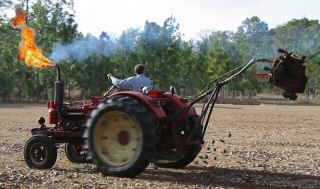Break a tractor (pull engine)
Since most small tractors don't have frames, removing the engine involves "breaking" the thing in two. This really is not as scary as it looks. The procedure is generally the same for most tractors we've dealt with.
1. Drain the radiator. Save fresh coolant. Old coolant should be disposed of properly. Don't feed it to your neighbor's cat. Cats and possums love antifreeze. It kills possums and makes mean drunks of the cats. Block the tires, fore and aft.
2. Drain and store fuel. Don't pour it on ant beds or feed it to your neighbors' cats.
3. Remove hood, grill, and such sheetmetal as needed to access radiator. Remove radiator hoses. Unbolt radiator. Usually there are 1 or two bolts underneath and some side braces.
4. Put a jack stand under the transmission. You may want to jack up the front end a little and lower the tractor onto the jack.
5. Disconnect the front end. On Farmalls, just 4 bolts on the front and one on the steering column are all that are needed. You may have to pull the generator or other accessories to get to some areas. On Fords, you have radius arms and steering arms to disconnect, too. You should end up with an engine dangling in front of the jack.
6. Disconnect anything between the engine and rest of the tractor, except the attachment bolts. This can include starter and generator cables, electrical wiring, fuel line, throttle, choke, oil pressure line, etc. Just look at the parting line between engine and trans and undo anything that crosses.
7. Now you need to support the engine. A shop crane is great. A boom on another tractor is good, too. If you put a chainfall to the rafters, make sure they are sturdy enough. We sometimes put a 2x12 over 3 rafters to spread the load for small engines. We don't recommend the oak tree method because things will be out in the weather for a while. If the engine has some attach hooks, great! If the head has some long studs, you can bolt a short piece of chain from front to back. A couple of nylon straps around the belly work, too.
8. Use your hoist of choice to put some tension on your lift chain/straps and start loosening the engine bolts. If the crack gets wider at the top, put a little more pull on it. If the crack gets wide on the bottom, ease back a touch.
9. With all the bolts out, slide the engine forward until it clears the transmission shaft. Don't bend or bang anything. Bag and label all the small parts and hardware to save yourself a lot of grief later.
10. Bolt it to the engine stand. Well, we recommend a stand. The ones we use will roll around and allow us to turn the engine over to get to the bottom. Some engines have to have the flywheel removed to mount up. Looking at a couple of our projects, it might be best just to pull the flywheel as a matter of course. A lot depends on just how far into the engine you are going. Our Ford was just getting a clutch and a top overhaul, so we left the wheel on. Before you turn the engine over or pull the pan, drain the oil and dispose of it properly.

2
straps give a more stable ride to the engine shed.
OK, so we
doctored the photo a little!
Wheels
chocked, trans on a stand.
Strap
it, unbolt and ease it out.
A handy bonus of using ratchet straps is that it is really easy to level the engine when you put it back in!
Gently!
On
the stand.
Farmall
Eco-system (ratsnest)
